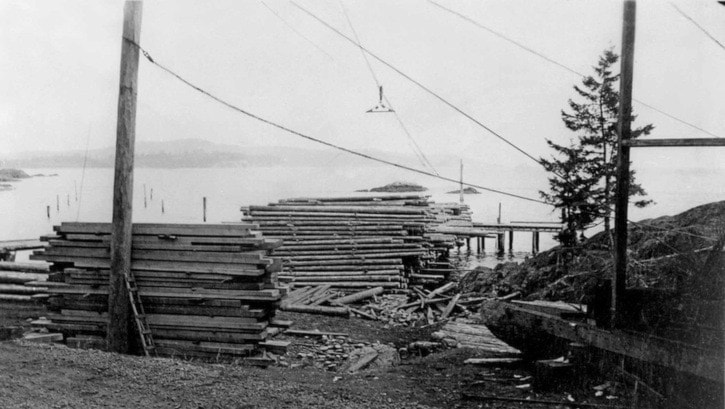Driving out West Coast Road just past the turnoff for Kemp Lake Road, if you were back in the mid-1930s and looked out to sea, this interesting sky line rigging would have met your eyes. The steam-powered Boyd mill was established farther west, at the far end of Blueberry Flats, off into a side road which was actually once the historic “tan bark” trail.
The cut was milled and then hauled by truck to this open area, part of the old Joe Poirier farm, where the stacks of milled lumber were set at the water’s edge. Upper, a slack cable skyline ran to a steam donkey out of camera view. Beneath it, one can see the line rigged from the spar pole out to a “tail hold” on the little off-shore rock/island.
Note a loading device on the sky line which picked up the sling loads and carried them, governed by blocks, out to where a dolphin had been driven offshore, where a scow would be waiting near the wharf for loading. Douglas fir pilings are also seen here, awaiting transport to Vancouver for creosoting.
The loaded scow would be towed by tugboat to markets in Victoria or Vancouver or local sales. Some of the lumber went in to the building of the Sooke Community Hall in 1937. In 1938 the towboat JWP skippered by Arthur MacFarlane towed some of the Douglas fir to Port Renfrew for Malahat Logging to use in the construction of the Bear Creek Trestle.
Standing 235 feet above the creek, the trestle was considered the highest wooden structure in the world, and Howard Elder used to assure us that the Douglas fir was, pound for pound, stronger than steel.
Velma (Cook) Jessiman has lived near this scene all her life and recalls as a youngster watching the Boyd operations. The Boyd Lumber Company camp had a cookhouse, commissary, bunkhouses, cottages, and employed up to 60 men. It all came to an end, though. Mill fires are fairly common occurrences and that’s what happened here – just before World War II, the mill burned to the ground.
Elida Peers,
Historian
Sooke Region Museum
